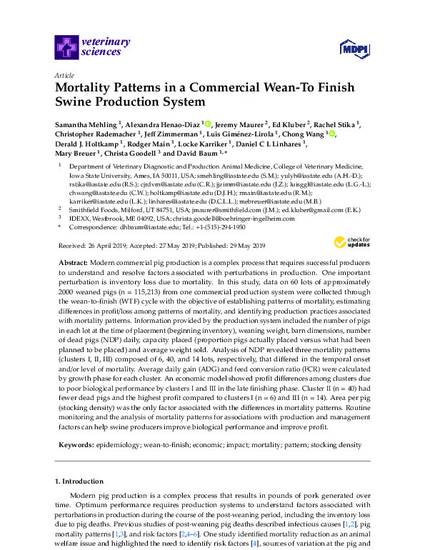
Modern commercial pig production is a complex process that requires successful producers to understand and resolve factors associated with perturbations in production. One important perturbation is inventory loss due to mortality. In this study, data on 60 lots of approximately 2000 weaned pigs (n = 115,213) from one commercial production system were collected through the wean-to-finish (WTF) cycle with the objective of establishing patterns of mortality, estimating differences in profit/loss among patterns of mortality, and identifying production practices associated with mortality patterns. Information provided by the production system included the number of pigs in each lot at the time of placement (beginning inventory), weaning weight, barn dimensions, number of dead pigs (NDP) daily, capacity placed (proportion pigs actually placed versus what had been planned to be placed) and average weight sold. Analysis of NDP revealed three mortality patterns (clusters I, II, III) composed of 6, 40, and 14 lots, respectively, that differed in the temporal onset and/or level of mortality. Average daily gain (ADG) and feed conversion ratio (FCR) were calculated by growth phase for each cluster. An economic model showed profit differences among clusters due to poor biological performance by clusters I and III in the late finishing phase. Cluster II (n = 40) had fewer dead pigs and the highest profit compared to clusters I (n = 6) and III (n = 14). Area per pig (stocking density) was the only factor associated with the differences in mortality patterns. Routine monitoring and the analysis of mortality patterns for associations with production and management factors can help swine producers improve biological performance and improve profit.
Available at: http://works.bepress.com/chong-wang/106/

This article is published as Mehling, Samantha, Alexandra Henao-Diaz, Jeremy Maurer, Ed Kluber, Rachel Stika, Christopher Rademacher, Jeff Zimmerman, Luis Giménez-Lirola, Chong Wang, Derald J. Holtkamp, Rodger Main, Locke Karriker, Daniel C.L. Linhares, Mary Breuer, Christa Goodell, and David Baum. "Mortality Patterns in a Commercial Wean-To-Finish Swine Production System." Veterinary Sciences 6, no. 2 (2019): 49. DOI: 10.3390/vetsci6020049. Posted with permission.